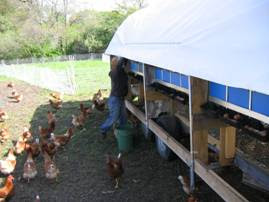Broad Context

A farm is a complex system that involves the movement of vast amounts of mass and energy. This warrants a certain degree of foresight. Most farmers make business plans that look years into the future. A key part of this is the articulation of goals and strategies to achieve those goals. A farm design is a spatial energetic plan that can be anything from a snapshot of the present to a multi-generational road map to a farm for the future. The key is to put goals and strategies into the context of the whole farm, watershed, foodshed, ecology, and community resilience.
Sense of Place
Understanding place begins with information gathering. It means walking the land. Watching the effects of the earth moving around the sun. Seeing wet and dry. Making lists, maps, and diagrams. Watching the animals including humans. (It can be very hard to step outside oneself, especially in the routines of agriculture. Yet it is useful to take time away from the routine in order to get the mental space needed to examine it.) Observation can lead to a deeper understanding of the system beyond what needs to get done. Cows prefer to walk up hill and towards light. People tend to not put things away if the storage place is hard to access. This roof is covered in moss, that one isn’t.
Design is a process The challenge is applying big picture goals to the complex situation of a real farm. This is not just about a new barn or greenhouse. It is about hopes, dreams, and expectations mixed with budgets, phases, and coordinated steps towards a set of goals. A far-reaching design will create an infrastructure that is adaptable to changes in climate, economy, society, or the changing needs of the farmer and her family. The design process should be set up to mimic the dynamic reality of a farm. Make it flexible, adaptable, and useful when a set of plans gets pulled off the shelf in 10 years. The process itself can create its own benefits, such as the transfer of experience from one person’s mind to a group leading to a more stable system of shared knowledge. Tracking how decisions were made will provide useful information as ideas naturally get revisited.
The challenge is applying big picture goals to the complex situation of a real farm. This is not just about a new barn or greenhouse. It is about hopes, dreams, and expectations mixed with budgets, phases, and coordinated steps towards a set of goals. A far-reaching design will create an infrastructure that is adaptable to changes in climate, economy, society, or the changing needs of the farmer and her family. The design process should be set up to mimic the dynamic reality of a farm. Make it flexible, adaptable, and useful when a set of plans gets pulled off the shelf in 10 years. The process itself can create its own benefits, such as the transfer of experience from one person’s mind to a group leading to a more stable system of shared knowledge. Tracking how decisions were made will provide useful information as ideas naturally get revisited.
Good design is the communication of ideas
At my most wonderfully inarticulate moments my wife kindly reminds me of the adage “if you can’t explain something then you don’t understand it.” I believe there are other ways to understand things that don’t involve words, but the concept is very important. The simple act of articulation brings about varied levels of understanding and points of view. It is a way to test ideas and show them to others. Perhaps one articulates the land by mapping it. That act of representing the sensory experience of a place is a powerful way for the designer to see a point of view and test ideas. The result is a sharable view that can be exchanged with apprentices, neighbors, contractors, or lenders. Simple diagrams that show a process or relationship can clarify leverage points and guide decisions of where the effort of time or money should be invested.
Innovation, beauty, and durability 
At some point design becomes reality; whether that means a hedgerow or barbed wire fence. For all the practical reasons to take certain actions it can be easy to leave out the simple poetry of a clever, handsomely crafted, and rugged product. I would not consider it superfluous to take the extra time to make something special. A farmer I know recently put up some new paddocks and needed half a dozen gates. He bought some, but the ones he would pass through each day he made himself. They were composed of the left over arched tubular steel from an old greenhouse. He used the curved pieces to make an elegant series of gates that will be enjoyed for years and bring pleasure as he passes through them.
Be humble
Despite all the lofty goals we can throw at any endeavor, I will never forget the wise words once said to me as I fussed over an eighth of an inch while placing a new beam above a pig pen. The farmer watched me squint at my level and rolled her eyes. As she walked away, she called out, “Done is perfect.”
Jesse Selman will co-teach a course on Farm Design/Build this fall (October 25-November 6, 2009) at the Yestermorrow Design/Build School in Warren, VT. He approaches green building and design with over a decade of experience growing food and creating and managing sustainable farmscapes. In 2003, he created Small Farm Builder offering sustainable agriculture infrastructure design and a pedagogical building experience to non-profits and small farms. He has worked with numerous farms on master plans, infrastructure implementation, housing, root cellars & farm structures. As a farmer and educator his experience ranges from animal husbandry to watershed stewardship. He currently works at Coldham & Hartman Architects - a firm committed to ecologically intelligent design – while pursuing his graduate studies in architecture.
